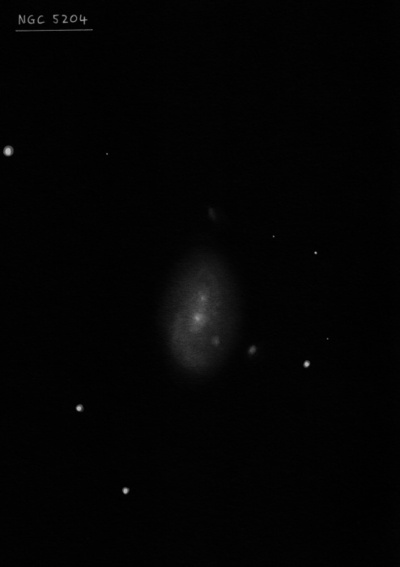
William Herschel discovered NGC 5204 = H IV-63 = h1625 on 24 Apr 1789 (sweep 926) and recorded "cB, cL, vgmbM, easily res. I suppose with a higher power I might have seen the stars." His position was poor -- 35 seconds of RA east of UGC 8490. John Herschel made a single observation and noted "pB; irreg R; gbM; 90"; r; no nucleus seen." His RA was 8 seconds too small. Edward Fath commented that NGC 5204 may be UGC 8490 (No. 627 in Table 1) in his 1914 paper "A Study of Nebulae". He remarked it was "irregular with a number of condensations", based on a plate taken with the Mt Wilson 60-inch.
Charles E. Burton, the Birr Castle observer on 23 Apr 1868, recorded "E ns, dark lane np sf on north side of nucleus. Suspect a spiral branch on np side extending to a star sp. Two stars sf, is the following of the 2 nebulous?"
200/250mm - 8" (4/24/82): faint, moderately large, diffuse, elongated N-S.
400/500mm - 17.5" (6/3/00): moderately bright, elongated 4:3 N-S, 3.5'x2.5', weak concentration. Has a mottled appearance with several slightly brighter knots across the face of the galaxy [on the DSS, the galaxy is quite unusual with numerous knots]. The outer halo fades into the background. A nice fairly bright double star is near the edge of the field. Member of the M101 group.
600/800mm - 24" (6/12/18): fairly bright, fairly large, oval N-S, ~3.5'x2.5', irregular halo, broad concentration to a large, very ill-defined central region but no nucleus. The surface brightness is notably irregular or mottled due to numerous blue compact HII regions, but no individual regions were resolved on the face of the galaxy.
Notes by Steve Gottlieb